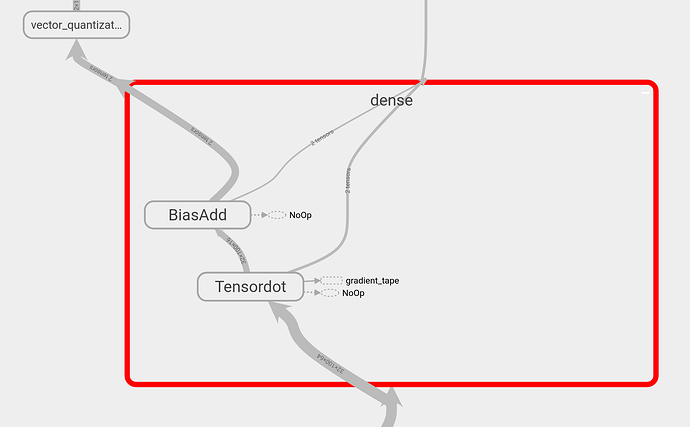Hi, a follow up to my other threads:
I am benchmarking my new implementation in comparison to my old implementation of my recurrent autoencoder. However, for my new implementation, for some reason the initial startup before running the first epoch of the training is very slow. Subsequent epochs seem fine (and are faster than for my old implementation. For the old implementation, the startup is normal and does not take long (training starts almost instantly) with the otherwise identical code.
Here is what I do
import tensorflow as tf
import numpy as np
import time
class FRAEOld(tf.keras.Model):
def __init__(self, latent_dim, shape, ht, n1, n2, n3, n4, batch_size=1, bypass=True, trainable=True, **kwargs):
super(FRAEOld, self).__init__(**kwargs)
self.latent_dim = latent_dim
self.shape = shape
self.ht = ht
self.batch_size = batch_size
# self.buffer = tf.Variable(initial_value=tf.zeros(shape=(batch_size,shape[0] * self.ht), dtype=tf.float32), trainable=False)
self.SetupBuffer(batch_size, shape[0], ht)
self.bypass = bypass
self.quantizer = None
self.trainable = trainable
self.l1 = tf.keras.layers.Dense(n1, activation='tanh', input_shape=shape)
self.l2 = tf.keras.layers.Dense(n2, activation='tanh') # has to be fixed to n2
self.ls = tf.keras.layers.Dense(latent_dim, activation='swish')
self.l3 = tf.keras.layers.Dense(n3, activation='tanh')
self.l4 = tf.keras.layers.Dense(n4, activation='tanh')
self.l5 = tf.keras.layers.Dense(shape[-1], activation='linear')
self.save_encoded = False
self.encoded_list = []
def SetupBuffer(self, batch_size, input_dim, ht):
self.buffer = tf.Variable(initial_value=tf.zeros(shape=(batch_size, input_dim * ht), dtype=tf.float32),
trainable=False)
self.batch_size = batch_size
def get_config(self):
config = super(FRAE, self).get_config().copy()
config.update({'latent_dim': self.latent_dim, 'bypass': self.bypass, 'quantizer': self.quantizer,
"l1": self.l1, "l2": self.l2, "ls": self.ls, "l3": self.l3, "l4": self.l4, "l5": self.l5,
"ht": self.ht, "batch_size": self.batch_size, "shape": self.shape, "name": self.name})
return config
# @tf.function(experimental_compile=True)
def resetBuffer(self):
self.buffer[:, :].assign(tf.zeros(shape=(1, self.shape[0] * self.ht), dtype=tf.float32))
def quantize(self, x):
x_np = x.numpy().astype(np.float32)
return self.quantizer.cluster_centers_[self.quantizer.predict(x_np), :]
def call(self, x):
if self.bypass:
return x
decoded = tf.TensorArray(tf.float32, size=tf.shape(x)[1])
for i in tf.range(tf.shape(x)[1]):
xslice = x[:, i, :]
xin = tf.concat((xslice, self.buffer), axis=1)
encoded = self.ls(self.l2(self.l1(xin)))
if self.save_encoded:
self.encoded_list.append(encoded.numpy())
if self.quantizer is not None:
encoded = tf.py_function(self.quantize, [encoded], tf.float32)
decin = tf.concat([encoded, self.buffer], axis=1)
y = self.l5(self.l4(self.l3(decin)))
decoded = decoded.write(i, y)
i += 1
self.buffer.assign(tf.concat([y, self.buffer[:, :-self.shape[0]]], axis=1))
tmp = tf.transpose(decoded.stack(), [1, 0, 2])
return tmp
class VectorQuantization(tf.keras.layers.Layer):
def __init__(self, codebook = None, record_data = False, **kwargs):
super(VectorQuantization, self).__init__(**kwargs)
self.codebook = codebook
self.record_data = record_data
def SetCodebook(self, codebook):
self.codebook = codebook
@tf.custom_gradient
def call(self, inputs):
def grad(dy):
return 1
if self.codebook:
# Flatten input tensor
input_shape = tf.shape(inputs)
flat_inputs = tf.reshape(inputs, [-1, self.embedding_dim])
# Reshape codebook for distance calculation
reshaped_codebook = np.expand_dims(self.codebook, axis=0)
# Calculate distances between inputs and codebook vectors
distances = tf.reduce_sum(tf.square(tf.expand_dims(flat_inputs, axis=1) - reshaped_codebook), axis=2)
# Find the index of the closest centroid for each input
embedding_indices = tf.argmin(distances, axis=1)
# Gather closest embeddings from codebook
quantized = tf.gather(tf.convert_to_tensor(self.codebook), embedding_indices)
# Reshape quantized tensor to match input shape
quantized = tf.reshape(quantized, input_shape)
return quantized, grad
else:
return inputs, grad
class FRAEEncoder(tf.keras.layers.Layer):
def __init__(self, input_shape, latent_dim, layer_config, **kwargs):
super(FRAEEncoder, self).__init__(**kwargs)
self.SetupLayers(input_shape, latent_dim, layer_config)
def SetupLayers(self, input_shape, latent_dim, layer_config):
self.encoder = []
activations = layer_config["activations"]
num_neuron = layer_config["neurons"]
for i, act in enumerate(activations):
if i == 0:
self.encoder.append(tf.keras.layers.Dense(num_neuron[i], activation=act, input_shape=(input_shape,)))
else:
self.encoder.append(tf.keras.layers.Dense(num_neuron[i], activation=act))
if len(activations) > 0:
self.encoder.append(tf.keras.layers.Dense(latent_dim, "swish"))
else:
self.encoder.append(tf.keras.layers.Dense(latent_dim, "swish", input_shape=(input_shape,)))
def call(self, inputs, state):
# encoder
encoded = tf.concat([inputs, state], axis=-1)
for lrs in self.encoder:
encoded = lrs(encoded)
new_output = encoded
return new_output
class FRAEDecoder(tf.keras.layers.Layer):
def __init__(self, output_dim, layer_config, **kwargs):
super(FRAEDecoder, self).__init__(**kwargs)
self.SetupLayers(output_dim, layer_config)
def SetupLayers(self, output_dim, layer_config):
self.decoder = []
activations = layer_config["activations"]
num_neuron = layer_config["neurons"]
for i, act in reversed(list(enumerate(activations))):
self.decoder.append(tf.keras.layers.Dense(num_neuron[i],activation=act))
self.decoder.append(tf.keras.layers.Dense(output_dim, activation='linear'))
def call(self, encoded, state):
y = tf.concat([encoded, state], axis=1)
for lrs in self.decoder:
y = lrs(y)
#update output and state
new_output = y # Result of some operations on `combined`
new_state = tf.concat([new_output, state[:, :-tf.shape(new_output)[-1]]], axis=-1)
return new_output, new_state
class FRAE(tf.keras.Model):
def __init__(self, output_dim, latent_dim, ht, layer_config={"activations":[],"neurons":[]} , **kwargs):
super(FRAE, self).__init__(**kwargs)
self.output_dim = output_dim
self.ht = ht
self.encoder = FRAEEncoder(output_dim, latent_dim, layer_config, name=self.name+"_Encoder")
self.decoder = FRAEDecoder(output_dim, layer_config, name=self.name+"_Decoder")
self.quantizer = VectorQuantization(name=self.name+"_VQ")
def SetQuantizer(self, codebook):
self.quantizer.SetQuantizer(codebook)
def call(self, x, return_quantized=False):
state = tf.zeros(shape=(tf.shape(x)[0], tf.shape(x)[2] * self.ht))
x_unstacked = tf.unstack(x, axis=1)
output_list = [None] * len(x_unstacked)
for i, inputs in enumerate(x_unstacked):
encoded = self.encoder(inputs, state)
encoded_q = self.quantizer(encoded)
decoded, state = self.decoder(encoded_q, state)
output_list[i] = decoded
outputs = tf.stack(output_list, axis=1)
if return_quantized:
return outputs, encoded_q
else:
return outputs
if __name__ == '__main__':
output_dim = 8
latent_dim = 6
ht = 1
with tf.device('/cpu'):
initdata = np.random.rand(256,1,output_dim)
data = np.random.rand(256*10, 3000, output_dim)
layer_config = {'activations':['tanh','tanh'], 'neurons':[20,20]}
frae = FRAE(output_dim, latent_dim, ht, layer_config)
fraeold = FRAEOld(latent_dim, (output_dim,),ht, 20,20,20,20,256,False)
frae(initdata)
fraeold(initdata)
frae.summary()
fraeold.summary()
loss = tf.keras.losses.mse
frae.compile(optimizer='adam', loss=loss, run_eagerly=False)
frae.fit(data, data, epochs=10, batch_size=256, verbose=1)
print("Done")
This takes ages to start the first epoch (about 15 minutes). If I replace “frae.fit(…)” with “fraeold.fit(…)” training starts virtually instantly. So the data size cannot be the sole reason for the slow down.
Does anyone know what is the reason and how to solve it? It is really annoying albeit it is not too bad if I train for many epochs.


